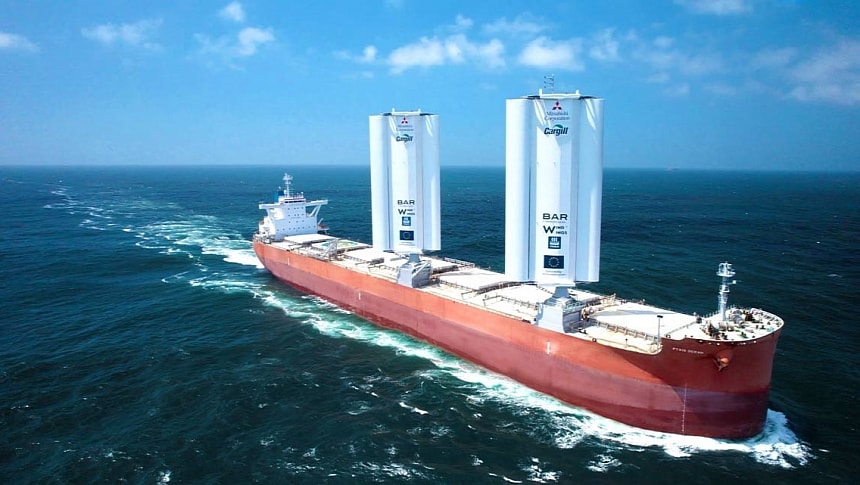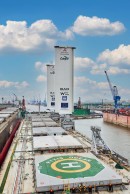Pyxis Ocean is not a new-generation bulk carrier. Yet, it is now officially a pioneer in green shipping after having ended its first six-month-long ocean trial as a retrofitted ship with great results. It's a huge milestone not just for Cargill and BAR Technologies but also for the global shipping industry.
In August 2023, the Pyxis Ocean embarked on its trailblazing journey. For the following six months, it made its way through the Indian Ocean, the Pacific Ocean, North and South Atlantic, passing Cape Horn and the Cape of Good Hope. What made this voyage different was the fact that it was partly wind-powered.
Pyxis Ocean is officially a Kamsarmax, which is a type of huge bulk carrier sporting the biggest size allowed in the Panamax category, yet it is still able to enter the Kamsar port in Guinea. By design, this type of ship is already meant to improve cargo capacity and fuel efficiency, but this MC Shipping vessel took a step further by adding an innovative sailing system onboard.
The sailing solution developed by BAR Technologies is inspired by aircraft wings, hence the name WindWings. These huge sails can be as tall as 37,5 meters (123 feet) and are installed vertically and controlled digitally via a control panel on the bridge.
They literally help propel the vessel so that it can maintain the same speed as a regular carrier but burn less fuel by turning down the engine. Plus, like most of today's sailing systems, the WindWings can operate autonomously, using onboard sensors to self-adjust.
When the retrofitted Pyxis Ocean hit the ocean with two WindWings onboard, it officially became the world's first wind-powered ocean vessel to embark on a green voyage. At the end of the six-month trial, Cargill was proud to report that the operation was a success. What this looks like in numbers is a reduction of approximately 3 tons of fuel per day. On days when sailing conditions were nearly perfect, fuel savings during the trip were as high as 11 tons. Also, considering that typical bulk carriers would normally require three WindWings onboard, numbers could go even higher.
American food giant Cargill was one of the main players behind this pioneering project through its Ocean Transportation branch. The goal was to confirm WindWings' real-world potential for saving emissions derived from shipping.
Modern sailing technologies such as this one are being developed in response to IMO's (the International Maritime Organization) targets for 2030, which require ships to have at least five percent of energy coming from clean sources.
Wind-assisted propulsion is clearly one of the ways to go, but the other piece of the puzzle has to do with infrastructure. One of the findings of this breakthrough voyage was that all ports and terminals should also do their part to accommodate retrofitted ships and these emerging technologies.
Pyxis Ocean is officially a Kamsarmax, which is a type of huge bulk carrier sporting the biggest size allowed in the Panamax category, yet it is still able to enter the Kamsar port in Guinea. By design, this type of ship is already meant to improve cargo capacity and fuel efficiency, but this MC Shipping vessel took a step further by adding an innovative sailing system onboard.
The sailing solution developed by BAR Technologies is inspired by aircraft wings, hence the name WindWings. These huge sails can be as tall as 37,5 meters (123 feet) and are installed vertically and controlled digitally via a control panel on the bridge.
They literally help propel the vessel so that it can maintain the same speed as a regular carrier but burn less fuel by turning down the engine. Plus, like most of today's sailing systems, the WindWings can operate autonomously, using onboard sensors to self-adjust.
When the retrofitted Pyxis Ocean hit the ocean with two WindWings onboard, it officially became the world's first wind-powered ocean vessel to embark on a green voyage. At the end of the six-month trial, Cargill was proud to report that the operation was a success. What this looks like in numbers is a reduction of approximately 3 tons of fuel per day. On days when sailing conditions were nearly perfect, fuel savings during the trip were as high as 11 tons. Also, considering that typical bulk carriers would normally require three WindWings onboard, numbers could go even higher.
American food giant Cargill was one of the main players behind this pioneering project through its Ocean Transportation branch. The goal was to confirm WindWings' real-world potential for saving emissions derived from shipping.
Modern sailing technologies such as this one are being developed in response to IMO's (the International Maritime Organization) targets for 2030, which require ships to have at least five percent of energy coming from clean sources.
Wind-assisted propulsion is clearly one of the ways to go, but the other piece of the puzzle has to do with infrastructure. One of the findings of this breakthrough voyage was that all ports and terminals should also do their part to accommodate retrofitted ships and these emerging technologies.










